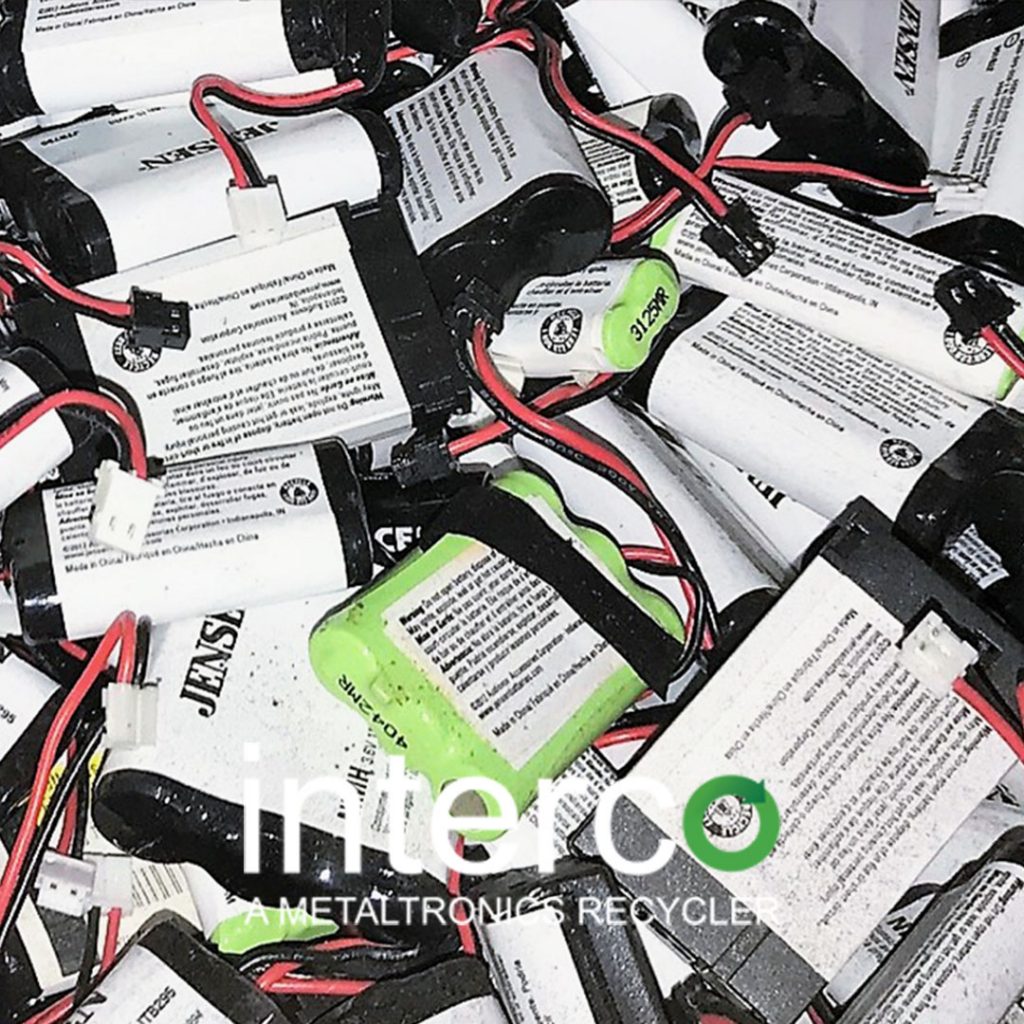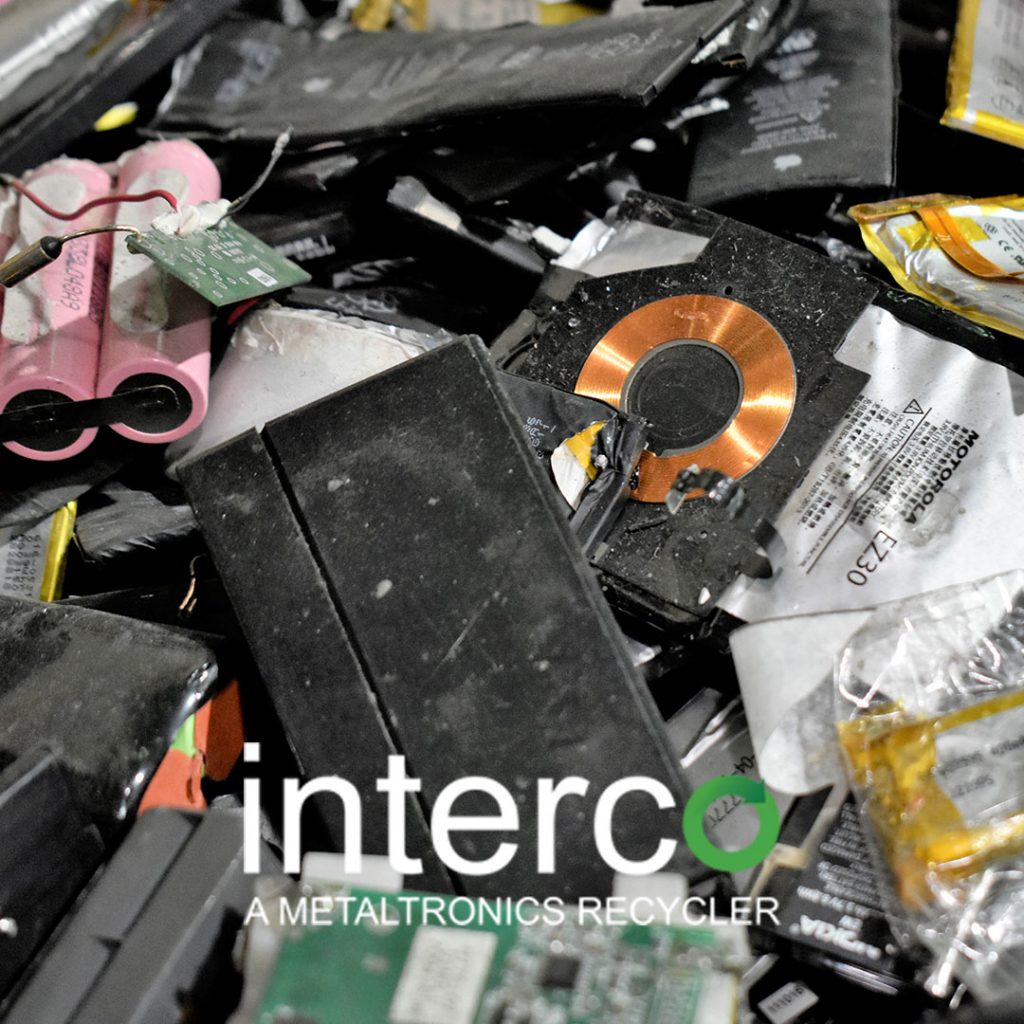Why You Should Recycle Batteries
Why You Should Recycle Batteries
Interco recycles batteries of all shapes, sizes, and chemistry. You should recycle batteries for a number of reasons. Recycling batteries helps the environment by keeping hazardous material out of landfills and reduces the need to mine elemental metals for industrial production needs.
Battery manufacturers produce several types of batteries in use today. Different recycling processes are available for each to recover and recycle the materials. Depending on the content – whether it’s metallic, plastic, or chemical – recycling at different stages of the production cycle often determines whether recycling is feasible or not.
The 9 Most Common Battery Types
- Lead-Acid
- Lithium-Ion (Li-ion)
- Nickel-Metal Hydride (NiMH)
- Nickel-Cadmium (NiCd)
- Absolyte
- Alkaline
- LiFePO4 Lithium Iron Phosphate
- Lithium Primary & Lithium Button Cells
- LiMnO2 Lithium Manganese Dioxide

1. Lead-Acid Battery & Lead Acid Battery Recycling
Americans recycle Lead-Acid batteries more than any other batteries. Consumers primarily use them in automobiles, motorcycles, smaller vehicles, ATVs and golf carts. They also use them in boats and other marine equipment. Manufacturers and other industrialists use Lead-Acid batteries in industrial heavy equipment and forklifts as well. Lead-Acid batteries are very reliable as backup or auxiliary power as an uninterruptible power supply (UPS) in computers, data centers, telecommunication and hospitals.
Interco recycles Lead-Acid batteries primarily for their lead content. The machines shred the whole batteries and sort the plastic and lead. Then they separate and clean the different materials while and drain and neutralize the acid. The process reintroduces the lead as industrial material for commercial production. Is recycling Lead-Acid batteries important? Today over 50% of the lead supply comes from recycled batteries.

2. Lithium-Ion Battery & Lithium Ion Recycling
Interco recycles Lithium-Ion batteries, keeping them out of landfills to extract and re-use cobalt and other precious metals contained within the Lithium-Ion battery itself. Consumer electronics, laptops, cell phones and other electronic devices which require high capacity utilize the Lithium-Ion battery – also referred to as a LIB. These devices require smaller rechargeable batteries.
Recycling these batteries prevents future shortage of cobalt and nickel through careful hydrometallurgical and pyrometallurgical processes. When you recycle batteries, the cost of extracting lithium through recycling is up to five-times as expensive as the mining process itself, therefore, many companies are unable to justify it at this time.

3. Nickel-Metal Hydride Battery & NiMH Hydride Recycling
Nickel-Metal Hydride batteries (NiMH or Ni–MH) utilize a combination of nickel and hydrogen – two naturally occurring elements. They use nickel oxide hydroxide to create energy. These batteries are often smaller and rechargeable. The batteries are often used in consumer goods and electronics, newer digital cameras and other high-drain devices.
Digital cameras, toys, handheld video games, and MP3 players all use NiMH batteries. Interco recycles Nickel-Metal Hydride batteries mainly to recover the nickel content. Although Nickel-Metal Hydride batteries are better for the environment than some others, they can still pollute the water table and air if not recycled. It is important to recycle batteries.

4. Nickel-Cadmium NiCd Battery or NiCad Battery & NiCad Battery Recycling
Nickel-Cadmium NiCd batteries also use nickel oxide hydroxide to create energy. Unlike with Nickel-Metal Hydride batteries, the Nickel-Cadmium batteries use metallic cadmium, which is a highly toxic environmental hazard. The EU has banned these rechargeable batteries for general public consumption and use in Europe because of their toxicity when illegally dumped in landfills or incinerated.
NiCad batteries are widely used with medical devices, alarm systems and emergency lighting, and power tools. It is important to recycle NiCd batteries as the metallic cell cylinder corrodes in landfills leaching cadmium into the water supply.

5. Absolyte Battery Recycling
All Absolyte batteries are valve-regulated, single-cell Lead-Acid batteries. Absolyte is a brand of valve-regulated sealed lead-acid battery that contains acid, lead, copper, and are housed in steel cases. In fact, older Absolyte batteries (housed in grey cases) contain Cadmium in the posts, while newer ones (black cases) do not. These batteries are often used on train and with industrial equipment. As a result, you should recycle batteries without question.
Cell phone and telecommunication networks use Absolyte batteries in backup power equipment. They are often the core of uninterruptible power supplies, maintenance-free (no topping-up), special high current performance battery. Lead-Acid batteries are used in the telecommunications field. Despite myths within the industry, this type of battery is highly recyclable. Accordingly, you should recycle batteries without question.

6. Alkaline Battery Recycling
Today alkaline batteries are the most common household batteries. First of all, household electronics such as children’s toys, remotes, and flashlights use these batteries most often. Alkaline batteries contain zinc and manganese; thus, the retrieval process is expensive.
While, you should recycle batteries without question. Because of the chemistry in alkaline, there is little to no monetary value, so there’s generally a charge to recycle this type of battery. It can take 6-10 times more energy to reclaim metals from some recycled batteries than from mining.

7. Lithium Iron Phosphate Battery & LiFePO4 Battery Recycling
Experts often refer to the Lithium Iron Phosphate (LiFePO4) battery as LFP. First of all, consumers can find this type of lower energy, rechargeable consumer battery in electric cars. They can also find them in solar panel applications as backup power sources.
Most importantly, these batteries often last longer and charge faster than other rechargeable batteries. In addition, they are frequently safer than the others. The compound used in lithium iron phosphate batteries (related to Lithium-Ion batteries) does not change to recycle batteries.

8. Lithium Primary Battery & Lithium Button Cells
Lithium Primary batteries use metallic lithium to generate power. The most recognizable type of Lithium Primary battery is the button cell watch battery, which is a small round single-cell battery. The button cells contain mercury or cadmium as well. As a result, Lithium Primary batteries are more volatile than many other batteries.
Lithium reacts violently when it comes in contact with moisture causing spontaneous combustion and fire. In addition, you should recycle batteries without question. It is very important in this case to recycle batteries. Similarly, if you dispose of Lithium Primary batteries in a landfill, the exposed lithium could ignite a fire and burn for years underground.

9. Lithium Manganese Dioxide Battery & LiMnO2 Battery Recycling
The Lithium Manganese Dioxide batteries – often referred to as LiMnO2 – are lightweight typically cylindrical or flat like buttons with stainless exteriors. Cameras, radios, medical equipment, and civil and military communication instruments commonly use these batteries. Therefore, these batteries self-discharge over time and cannot recharge.
Recycle Your Batteries with Interco
Americans use 3,000,000,000 – that’s three billion – batteries each year. That’s an average of eight batteries per person. Therefore, we must recycle these batteries. Click here to get a quote today.